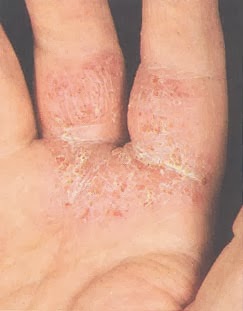Description: Inflammation of the skin or derma attended by itching and the exudation of serious matter; also referred to as atopic dermatitis.
Persons most commonly affected: All ages and both sexes and affects up to 15 percent of the population.
Organ or part of body involved: Skin
Symptoms and indications: In young children, the problem surfaces as a red, itchy, oozing, crusted rash on the face, scalp, diaper area, arms and legs. In older children and adults the rashes may appear as dry, red, scaly patches on the eyelids, neck and wrists, and in the folds of the elbow and knees, neck, hands, feet, genital area (between the legs), and around the rectum.
Causes and risk factors: Contact dermatitis: is caused by contact between the skin and an irritant substance. There are many substances that may irritate the skin, including soaps and detergents, industrial chemicals, some metals, cosmetics and plants, and for babies, urine, causing nappy rash. People who know that their skin is sensitive to a particular substance must try to avoid further contact with it. Light dermatitis: particularly in children, this may have no specific cause, other than a particular sensitivity to sunlight. However, in many sufferers, the condition is caused either by use of some drugs, or sometimes, a particular chemical in lipstick or a perfume in cosmetics. Sometimes, eczema is caused by food allergies such as milk, eggs or fish.
Prevention: Avoid scratching whenever possible. Cover the itchy area with a dressing, if you can\'t keep from scratching it. Trim nails and wear gloves at night. Dress appropriately. Doing so may help you avoid excessive sweating. Wear smooth-textured cotton clothing. This will help you avoid irritation. Avoid other irritants. These include wool carpeting, bedding and clothes, and harsh soaps and detergents. Quick, lukewarm showers are better than long hot baths for your skin. If you prefer to bathe, use lukewarm water and bathe for ten to twenty minutes only. Avoid using soaps: even a mild soap can dry and irritate skin. When you dry after a shower, pat yourself dry: rubbing can do as much damage to your skin as scratching. Once dry, moisturize with a gentle cream, ointment, or lotion. Avoid dust mites. The best strategies to minimize contact with dust mites are washing clothing and bed linens and vacuuming on a regular basis. Pillow and mattress wraps also help reduce contact with mites. Some people replace carpet with linoleum, wood or other flooring, as carpets tend to harbour large numbers of dust mites. Eat a diet of basic, whole foods to encourage a healthy balance and a balanced immune system. Consume essential fatty acids (EFA\'s) every day. Flaxseeds, flaxseed oil, and cold-water fish, especially salmon, mackerel, and herring, are good sources of EFA\'s. Eat pumpkin or sunflower seeds daily. They are excellent sources of zinc, a mineral that encourages the proper metabolism of EFA\'s. Eliminate all additives from the diet. Not only are additives likely to cause a direct reaction, they contribute to a toxic internal environment that can manifest in the skin. Avoid common food triggers of eczema such as diary, citrus fruits, tomatoes, soy, shellfish, eggs, wheat, and glutten. Stay away from inflammatory foods, especially sugar, spicy foods, diary, caffeine, and alcohol. A little morning sunlight on your skin promotes healing, so take walks early in the dya. If you live in warm climate, be careful. Do not let your skin burn.
Tips: * May be associated with zinc deficiency. Good sources of zinc include oysters, dairy products, beans, nuts, seeds (specially pumpkin seeds)and fortified breakfast cereals.
* A salt-water compress may help to relieve itching. Dissolve a teaspoon of pure, natural salt (not table sal) in one cup of warm water, soak a clean washcloth in i and apply to itchy areas of your skin.


No comments:
Post a Comment